Ode to Powerlines
Air Date: Week of January 16, 2009

(Photo: Brian Rosa)
Power lines give a pulse to the American landscape. So say cartographer Brian Rosa and photographer Adam Ryder who walked, camped, and lived in the shadow of Rhode Island’s power lines to try to understand how they impact the environment and people. Producer Ike Sriskandarajah (Srees –kahn-da-ra-jah) uncovers how the ubiquitous pylons and lines capture the imagination.
Transcript
CURWOOD: At some point, just about everyone has been out on the highway driving along, ignoring the subject of our next story.
Some of you may be ignoring it right now, even as it races alongside your car. I’m talking about the modest heroes of the American landscape - the high-tension power line!
Reporter Ike Sriskandarajah spoke with two explorers who just completed an investigation of these overlooked giants. Their project aims to uncover the secret life of power lines.
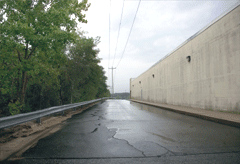
(Photo: Brian Rosa)
SRISKANDARAJAH: So these two guys – a cartographer …
ROSA: My name is Brian Rosa.
SRISKANDARAJAH: ...and a photographer …
RYDER: My name's Adam Ryder
SRISKANDARAJAH: … have been fascinated by power lines from a very young age.
RYDER: I spent a long time in the car with my parents on really long car rides, and I was an only child, so I would be looking out the window a lot.
SRISKANDARAJAH: Looking out the window, Brian and Adam both noticed the gently undulating curvy lines.
ROSA: I used to follow them with my finger kind of going up and down in almost sort of like a wavelength pattern when I was in the car.
[MUSIC: “I DON'T HAVE TO TRY. I DON'T HAVE TO SPEAK. I CAN WATCH THE COUNTRY SIDE.” THE SOUND OF A CAR STARTING. MUSIC: “AND I CAN FALL ASLEEP”]
SRISKANDARAJAH: There's something dreamy about the power lines and the land under them.
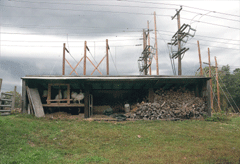
(Photo: Brian Rosa)
RYDER: Yeah absolutely, it’s a really unique tract of land that doesn’t have any development on it except for itself. So, it’s kind of, in a way its really pristine and untouched and…virginal, its kind of, kind of like, romantic and magical in that way.
SRISKANDARAJAH: Something inviting…
RYDER: It doesn’t appear to be monitored and there’s nobody out there so you can kind of imagine yourself or I would imagine myself like building a little house out there you know, living alone or something
SRISKANDARAJAH: Well young Adam didn’t end up moving there.
RYDER: [Laughs] I’d like to think he was that cool.
SRISKANDARAJAH: But this past year he and Brian got a grant from Rhode Island’s Arts Council to investigate and photograph the high-tension lines that stretch over most of Rhode Island. So they drove out to a small town called Burrillville parked their car and started walking.
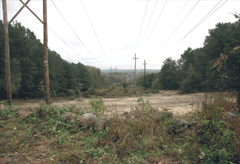
(Photo: Brian Rosa)
RYDER: When I got out of the car I tended to walk along the power lines in whatever the way was opposite of the way Adam was going
[COUNTRY SOUNDS]
SRISKANDARAJAH: And that’s when Brian heard something strange
ROSA: When we first started walking along the power lines I thought that there were a lot of cicadas -
[CICADA HUM]
ROSA: It didn’t actually occur to me that there is this excess energy escaping from these power lines that are actually making a constant electronic hiss all the time
[ELECTRICITY HUM]
SRISKANDARAJAH: These seemingly empty swatches of land are filled with sound.
ROSA: They make a loud buzzing sound
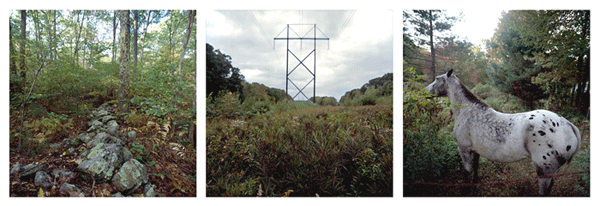
(Adam Ryder)
SRISKANDARAJAH: Maybe you have noticed some sort of sound too as you are driving by pole after pole after pole.
RYDER: They definitely provide a rhythm if you are driving past them on the highway, like if you are a commuter going past all these poles and they are evenly spaced.
[SOUND OF CARS PASSING]
RYDER: yeah- they kind of create a visual rhythm as they travel along the state.
[SOUND OF CAR DRIVING, MUSIC]
SRISKANDARAJAH: Like a heartbeat. These pillars are more than just dead trees…they really have a life of their own. As Brian and Adam continued to hike along the lines they saw that the land under and around the pylons is filled with a lot more than just sound.
ROSA: We were probably trespassing while we were there. There were a whole lot of other people doing that too - walking their dogs, riding their ATVs.
RYDER: We even found a stop sign on one of the power line poles and it was really crazy- I couldn’t figure out why it was there or who it was meant to protect but it seemed to be put up for motocross people or something! It was totally funny!
SRISKANDARAJAH: With a bit of amateur archeology Brian turned up even more.
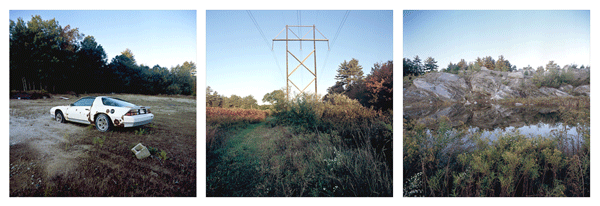
(Adam Ryder)
ROSA: Just seeing a fire pit that someone made and a few rocks with a wooden board across them where someone was sitting and people would just go have fires and sit around and drink and be delinquent and it kind of made me think back to my teenage years a little bit.
SRISKANDARAJAH: The power lines carve out a space for people to meet - but Brian and Adam say they connect us in another way.
ROSA: By following these power lines which seemed to cut through disparate areas that aren’t necessarily connected when looking from above you actually see that there is a continuum of rural to suburban to urban back to suburban to industrial and that they are all part of a vast network
RYDER: What’s really - I think actually awesome, is the best word I can use to say it - what’s really awesome about seeing this parade of power lines through the landscape, especially in rural areas is that we’re kind of seeing these, these tendrils connecting humanity as one large organism and it’s a cool way of looking at us, you know what I mean?
SRISKANDARAJAH: These are the power lines that bind. For Living on Earth I’m Ike Sriskandarajah.
[MUSIC: Arcade Fire “In The Backseat” from Funeral (Merge Records 2004)]
CURWOOD: Brian Rosa and Adam Ryder’s power line photographs and maps are on display at the Stairwell Gallery in Providence, Rhode Island through February fifth. Or, to see some of the pair’s photos, visit our website, loe.org.
Links
Living on Earth wants to hear from you!
Living on Earth
62 Calef Highway, Suite 212
Lee, NH 03861
Telephone: 617-287-4121
E-mail: comments@loe.org
Newsletter [Click here]
Donate to Living on Earth!
Living on Earth is an independent media program and relies entirely on contributions from listeners and institutions supporting public service. Please donate now to preserve an independent environmental voice.
NewsletterLiving on Earth offers a weekly delivery of the show's rundown to your mailbox. Sign up for our newsletter today!
 Sailors For The Sea: Be the change you want to sea.
Sailors For The Sea: Be the change you want to sea.
 The Grantham Foundation for the Protection of the Environment: Committed to protecting and improving the health of the global environment.
The Grantham Foundation for the Protection of the Environment: Committed to protecting and improving the health of the global environment.
 Contribute to Living on Earth and receive, as our gift to you, an archival print of one of Mark Seth Lender's extraordinary wildlife photographs. Follow the link to see Mark's current collection of photographs.
Contribute to Living on Earth and receive, as our gift to you, an archival print of one of Mark Seth Lender's extraordinary wildlife photographs. Follow the link to see Mark's current collection of photographs.
 Buy a signed copy of Mark Seth Lender's book Smeagull the Seagull & support Living on Earth
Buy a signed copy of Mark Seth Lender's book Smeagull the Seagull & support Living on Earth

